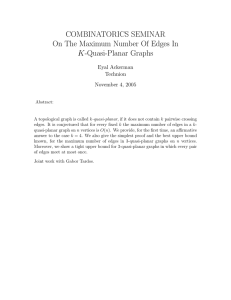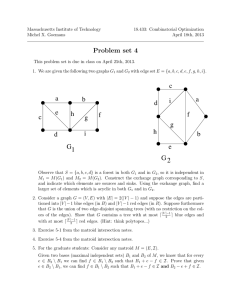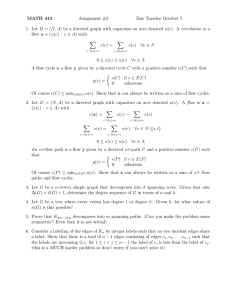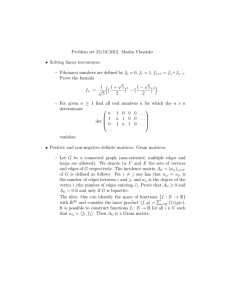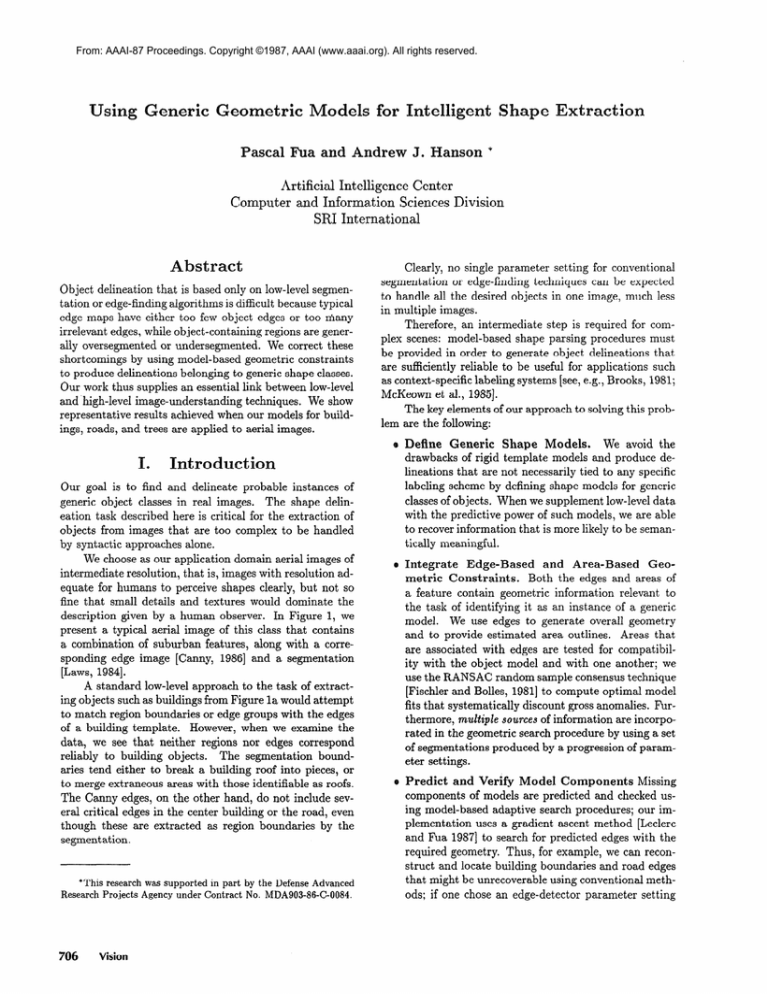
From: AAAI-87 Proceedings. Copyright ©1987, AAAI (www.aaai.org). All rights reserved.
Using
Generic
Geometric
Models
for
Sha
Intelligent
Pascal Fua and Andrew
J. Hanson
e Extraction
*
Artificial Intelligence Center
Computer and Information Sciences Division
SRI International
Abstract
Object delineation
that is based only on low-level segmentation or edge-finding
algorithms is difficult because typical
edge maps have either too few object edges or too many
irrelevant edges, while object-containing
regions are generally oversegmented
or undersegmented.
We correct these
shortcomings
by using model-based
geometric constraints
to produce delineations
belonging to generic shape classes.
Our work thus supplies an essential link between low-level
and high-level image-understanding
techniques.
We show
representative
results achieved when our models for buildings, roads, and trees are applied to aerial images.
I.
Introduction
Our goal is to find and delineate probable
instances of
generic object classes in real images.
The shape delineation task described here is critical for the extraction
of
objects from images that are too complex to be handled
by syntactic approaches alone.
We choose as our application
domain aerial images of
intermediate
resolution,
that is, images with resolution adequate for humans to perceive shapes clearly, but not so
fine that small details and textures would dominate
the
description
given by a human observer.
In Figure 1, we
present a typical aerial image of this class that contains
a combination
of suburban features, along with a corresponding
edge image [Canny, 19861 and a segmentation
[Laws, 19841.
A standard low-level approach to the task of extracting objects such as buildings from Figure la would attempt
to match region boundaries or edge groups with the edges
However, when we examine the
of a building
template.
data, we see that neither regions nor edges correspond
reliably
to building
objects.
The segmentation
boundaries tend either to break a building
roof into pieces, or
to merge extraneous areas with those identifiable
as roofs.
The Canny edges, on the other hand, do not include several critical edges in the center building or the road, even
though these are extracted
as region boundaries
by the
segment ation.
*This research was supported in part
Research Projects Agency under Contract
706
Vision
by the Defense Advanced
No. MDA903-86-C-0084.
Clearly, no single parameter
setting for conventional
segmentation
or edge-finding
techniques can be expected
to handle all the desired objects in one image, much less
in multiple images.
Therefore,
an intermediate
step is required for complex scenes: model-based
shape parsing procedures must
be provided in order to generate object delineations
that
are sufficiently
reliable to be useful for applications
such
as context-specific
labeling systems [see, e.g., Brooks, 1981;
McKeown
et al., 1985].
The key elements of our approach to solving this problem are the following:
8 Define
Generic
Shape
Models.
We avoid the
drawbacks of rigid template models and produce delineations that are not necessarily tied to any specific
labeling scheme by defining shape models for generic
classes of objects. When we supplement low-level data
with the predictive power of such models, we are able
to recover information
that is more likely to be semantically meaningful.
Integrate
Edge-Based
and
Area-Based
Geometric
Constraints.
Both the edges
- and areas of
a feature contain geometric
information
relevant to
the task of identifying
it as an instance of a generic
model.
We use edges to generate overall geometry
area outlines.
Areas that
and to provide estimated
are associated with edges are tested for compatibility with the object model and with one another; we
use the RANSAC random sample consensus technique
[Fischler and Bolles, 19811 to compute optimal model
fits that systematically
discount gross
anomalies. Furare incorpothermore,
multiple so&ces of information
rated in the geometric search procedure by using a set
of segmentations
produced by a progression of parameter settings.
Predict
and Verify
Model
Components
Missing
components
of models are predicted
and checked using model-based
adaptive search procedures;
our implementation
uses a gradient ascent method [Leclerc
and Fua 19871 to search for predicted edges
- with the
required geometry.
Thus, for example, we can reconand road edges
struct and locate building boundaries
that might be unrecoverable
using conventional
methods; if one chose an edge-detector
parameter
setting
weak enough to find such missing edges at the beginby irrelevant
ning, the edge map would be dominated
noise.
enerie
ePing
Q Strong
edge geometry.
The elementary
edge or
line data extractable
from an image must be related
in some direct and computable
way to the object.
In particular,
the model must suggest explicit rules
for dealing with anomalies and predicting
likely locations of missing geometrical
components.
Typical
models include edge geometry characterized
by long,
straight edge segments, by edges or lines with uniform
local curvature, and by edges with good statistical signatures characterizing
their jaggedness.
In addition,
there must be mechanisms for the production
of coherent area-enclosing
structures.
Thus, for example,
parallel edges, corners, equidistant
curved lines and
edges outlining
a compact shape are reasonable geometric substructures
that can be used to delineate
areas that are portions of the larger structure.
e Strong
area signature.
Areas contained within a
substructure
of a generic object should be characterizable by a computable
signature.
If anomalies are
expected,
they should be clearly distinguishable
by
using the area signature and should ideally comprise
no more than a small fraction
of the area. Examples of such areas are parking lots with cars or roofs
with chimneys. Typical area signatures would be the
presence of uniform
or uniformly
changing intensity
values or textures.
Anomalies
in such a background
are easily located and discounted
using a RANSAC
procedure to fit planes to the intensity
values within
the delineated area.
The models we have implemented
- buildings,
roads,
and trees - contain the following
universal
components:
(1) edge definition,
(2) composite
structure
definition,
(3) linking geometry specification
for composite structures,
(4) area signature specification,
and (5) a geometric completion model.
The components
of each of these models
are are summarized
in Table I.
The most general model-parsing
procedure
that we
have needed to interpret
each of these models in an image
includes the following steps:
the
edges
according
to
the
edge
relationships
based
combined
with
tests
areas.
011
Otl
geometric
signatures
3. Build
closed graphs
of related
edges that
close consistent
areas as well as matching
model
geometry.
People can classify instances of various object categories
accurately
even though a particular
instance may have a
unique shape they have never seen before. Generic shape
classes provide an effective approach to automating
this
human ability.
Generic models that we have found useful
for analysis of real images possess the following characteristics:
1. Build
tion.
2. Find
edge
constraints
of enclosed
defini-
4. Predict,
search for, and
of the model geometry.
5. Compare
the
characteristics
fill
in missing
resulting
delineation
of the original
model.
enthe
elements
with
the
The overall approach can clearly be extended to any other
object for which appropriate
characteristics
can be formulated, e.g, cylindrical
oil tanks, drainage patterns,
and
buildings with perspective
distortion.
In the following subsections, we outline the features of
our models for buildings,
roads, and trees, and illustrate
how these models fit into the general framework.
Where*
space allows, we mention some details of the individual
requirements of the model parsing framework outlined above.
A.
ectilinear
Networks
Our most extensive work so far has been devoted to the
task of delineating
rectilinear,
presumably
cultural,
structures [Fua and Hanson, 1985, 19861.
We characterize
buildings
and related cultural structures (e.g., parking
lots, patios,
gardens,
and courtyards) as rectilinear
networks of adjacent or joinable areaenclosing straight-edge
groups that contain areas with planar intensity.
The basic parsing procedure
for generic rectilinear
structures
follows the pattern
given above.
Since region boundaries of a histogram-based
segmentation
[Laws,
1984; Ohlander et al. 19781 tend to correspond to high image gradients, the straight edges are extracted as sequences
of pixels with consistent gradient directions.
While single
segmentations
often have inadequate
characteristics,
segmentations
with increasingly
permissive parameters
produce regions that are first undersegmented,
then well segmented and finally oversegmented
as shown in Figure 2.
The multiple
data sources lead to a network of geometrically consistent straight edges, shown in Figure 2f, that
serve as a basis for the geometric processes.
In practice, region boundaries
may deviate by a few
pixels from the actual edge location; we optimize their locations using the gradient ascent procedure.
In each of
the segmentation
regions, edges that are parallel or perpendicular
are singled out for special consideration.
These
associated edges, together with the region they come from,
define areas in the image. Areas are tested for consistency
with a RANSAC
planar fit in intensity
space, and edges
that generate qualifying areas are retained for further wrsing.
We note that the same edge can belong to several
structures.
If the structures are compatible with respect to
the structure-linking
specification
and enclosed-area characteristics,
new geometric
relationships
between edges,
IFua and Hanson
707
such as collinearity,
are instantiated.
The result is that
edges are grouped into networks defined by graphs of the
geometric relations among them.
Rectilinear
geometric relationships
are used to predict
how the edges should be linked and where missing edges
might be. The predictions
are fed to the adaptive straightedge finder [Leclerc and Fua, 19871 or to the F* edge finder
[Fischler, et al., 19811 i f a straight edge link is not found.
The networks of-compatible
composite structures
are
then connected to form closed contours and define new semantically
motivated
regions that are the final output of
the current system. The candidate features can be scored
characusing a measure of the closeness of the delineation
teristics to those expected in an ideal model instance.
In practice, the information
required to assign meaningful labels to candidate cultural
structures
can be very
primitive;
we shall give some examples below in which
even such simple techniques as clustering based on regionsimilarity
measures are quite effective.
B.
Roads-Curvilinear
Parallel
Networks
It is straightforward
to modify the rectilinear
cultural feature model to include smoothly
curving road segments.
The edges of such roads are almost straight in most places
and can be detected locally using the techniques
given
above. They are then grouped into parallel structures and
linked into elongated networks that may have large-scale
curvature.
To deal with winding roads, the straight edges
can be replaced by smoothly
curved edges while the rest
of the approach is retained.
See Table I for a summary.
The only major change in the road model is the rule
employed to predict missing components
of the geometric structure.
First, the initial network of parallel edges
is used to estimate the location of the road’s center and
width.
Next, we fit a spline to the estimated
center of
the road and use it to define two parallel splines that correspond to the road’s edges. Using the gradient
ascent
method, we optimize the location of the two splines under
the constraint
that they must remain parallel.
This is a
powerful technique because, wherever one side of the road
or occlusions, the edge inis lost due to poor photometry
formation
present on the other side can still be utilized to
guide the optimization
procedure.
C.
Trees-Irregular
Clumps
Clumps of vegetation,
typically
small groups of trees, are
characterizable
as being complementary
to the regular
cultural-object
models we have described so far.
Since
their edges are typically
jagged and irregular,
any compact object that has no components
resembling
roads or
buildings
could be a candidate for vegetation.
Other irregular objects such as rock outcroppings,
bodies of water,
and drainage patterns would have similar signatures.
The
tree model is summarized
in Table I.
The parsing procedure
for vegetation
clumps starts
with the boundary of a given segmentation
region and optimizes the location using gradient ascent. In contrast to
708
Vision
the building model, jagged parts of the boundary,
rather
than linear parts, are selected as edge candidates.
Within
single regions, jagged edges that have consistent neighboring areas computed
by local chamfering
are incorporated
The F* general linear-feature
into composite structures.
utility
is then used to connect the edges along the path
with the strongest image gradient.
This generates the required closed regions delineating
the vegetation candidate.
In this section we present some representative
results of
applying our approach to aerial imagery.
To illustrate
the behavior of the system on buildings,
we have chosen two images that are especially challenging
in terms of shape complexity
and faint edge photometry.
In Figure 3, we show the results of analyzing
the image
shown in Figure la. Figure 3a illustrates
the initial set of
networks, selected in this case on the basis of a size filter;
if we add a selection criterion based upon clustering areas
characteristics,
one of the clusters is
with similar intensity
the set of house candidates in Figure 3b.
Figure 4a shows another example of an image containing difficult-to-parse
cultural structures;
in particular,
note the extreme weakness of many relevant roof edges.
Figure 4b contains a cluster of bright enclosures that can
be identified as sunlit roofs, Figure 4c shows a corresponding cluster of shaded roof sections, and Figure 4d gives the
complete roof structures.
Turning
our attention
now to linear features,
we
take the image shown in Figure la and apply the model
The system finds the initial
for generic road segments.
set of straight
edges shown in Figure 5a, groups them
into equidistant
parallels, connects those that seem to be
collinear or smoothly curving, and then uses them to prediet the approximate
delineation
of the road as shown in
Figure 5b. Finally, the predicted
shape is optimized
with
respect to variations
in the global width and local curve
skeleton, thus yielding Figure 5c.
Finally, we apply the parsing procedure to vegetation
clumps. In Figure 6a, we show an image containing typical
vegetation clumps, along with one of a set of segmentations
in Figure 6b. The initial candidates for vegetation
clumps
are shown in Figure 6c, and a final selection filtered with
respect to image intensity in Figure 6d.
IV.
Conclusions
In this work, we have proposed
an approach
based on
generic models and a combination
of edge-driven
and
photometry-based
geometric reasoning to delineate several
classes of objects in aerial images. Such delineations
may
be utilized in a variety of ways, but are especially appropriate as input to high-level knowledge-based
systems. Since
these structures
are generic, there is no a priori commitment to any particular
labeling or modeling system.
We have devised methods for the following:
0 Integration
Sources.
of
Geometric
Multiple
Data
Data-driven
edge extraction
and image segmentation
processes do not perform well on multiple
target objects. We combine multiple
information
sources and
use both edge geometry and enclosed-area
characteristics to generate and verify shape hypotheses; we thus
make efficient use of the available geometric information in the image.
o Generic
Shape
Extraction.
For many important
tasks, the exact shapes of objects
of interest are not known. We define and use generic
models to deal with whole classes of objects. Within
the context of such models, we recover expected but
missing model components using adaptive search techniques, and compensate
for photometric
anomalies.
In particular,
we have proposed models for cultural
structures,
roads, and vegetation clumps, all of which
fit into a universal format for model definition
and
parsing.
The system’s effectiveness derives from the definition
and use of generic shape models to refine and interpret lowlevel image information.
The clear delineations that we can
produce are an essential step toward application-oriented
parsing schemes, and provide an adequate basis for rulebased labeling systems that could not function with traditional low-level data alone.
eferences
R.A.
Brooks, “Symbolic
Reasoning
Among
and 2-D Images,” Artificial
Intelligence
(1981).
3-D Models
Journal 16,
M.A.
Fischler and R.C. Bolles, “Random Sample Consensus: A Paradigm
for Model Fitting
with Applications to Image Analysis
and Automated
Cartography,” CACM, Vol. 24, No. 6, pp. 381-395 (June 1981).
M.A.
Fischler, J.M. Tenenbaum,
and H.C. Wolf,
“Detection
of Roads and Linear
Structures
in LowResolution
Aerial
Imagery
Using
a Multisource
Knowledge Integration
Technique,” Computer
Graphics and Image Processing 15, pp. 201-223 (1981).
P. Fua and A.J. Hanson, “Locating
Cultural
Regions in
Aerial Imagery Using Geometric
Cues,” Proceedings
of the Image Understanding
Workshop,
pp. 271-278
(December
1985).
P. Fua and A.J. Hanson, “Resegmentation
Using
Shape: Locating
General Cultural
Objects,”
Recognition
Letters (1986) in press.
K.I.
Generic
Pattern
Laws, “Goal-Directed
Texture Segmentation,”
Tech-,
nical Note 334, Artificial
Intelligence
Center, SRI International,
Menlo Park, California (September 1984).
Y. Leclerc and P. Fua “Finding
Object Boundaries
Using
Guided Gradient
Ascent,” Proceedings
of the 1987
Topical Meeting on Machine Vision, Lake Tahoe, CA,
pp.168-171
(March 1987).
D. McKeown,
W.A. Harvey, and
Based Interpretation
of Aerial
PAM1 7, pp. 570-585 (1985).
J. McDermott,
Imagery,” IEEE
“RuleTrans.
R. Ohlander,
K. Price, and D.R. Reddy, “Picture Segmentation Using a Recursive Region Splitting
Method,”
Computer
Graphics and Image Processing 8, pp. 313333 (1978).
J. Canny, “A Computational
Approach
to Edge Detection,” IEEE Trans. PAM1 8, pp. 679-698 (1986).
Figure
1: (a) A typical
segmentation.
aerial
image
with
suburban
features.
(b) A C army edge map.
(c) A Laws histogram-based
Fua and Hanson
709
Model
Component
Edge definition
Composite
structure
definition
Linking
geometry
specification
for composite
structures
Area signature
specification
Geometric
completion
model
Table I. Summary
khuldmgs
Roads
Trees
Straight
Curved
Jagged
Parallel
Cluster
Curvilinear
Free form
Parallel
and perpendicular
Rectilinear
Planar
Planar
intensity
intensity
1
Straight
of the characterstics
edge search
of each of three models
Planar
intensity
I
Curved
described
edge search
Connecting
path
search
in the text.
Figure
2: (a) A small image portion containing a cultural structure.
(b) A n extreme undersegmented
partition.
(c) An
undersegmented
partition.
(d) An optimum partition
for detecting the structure.
(e) A highly oversegmented
partition.
(f) Th e set of long straight edges extracted from the partition
boundaries
using the criterion that
the edges enclose as large a uniform rectilinear
area as possible. These edges form a network.
Figure
3: (a) Rectilinear
networks
region uniformity
filter.
710
Vision
meeting
a size criterion.
(b) H ouse-like
networks
found
by imposing
in an additional
Figure
4: (a) An image containing
complex
roof cluster. (d) House candidates
(4
buildings with some faint edges. (b) A sunlit roof cluster. (c) A shaded
constructed
by merging the sunlit and shaded roof candidates.
(b)
(4
Figure
(a) The edges that are originally
grouped together
as a possible road
5: An example of a road segment.
structure.
(b) Intermediate
prediction
of the road path given only the initial edges. (c) Final road position
optimized
to choose best path with the same (variable)
width for the entire length.
Figure
vegetation
clumps.
(b) One of a family of segmentations
used to derive edge
6: (a) A n image containing
candidates.
(c) The initial set of vegetation
clump candidates.
(d) Vegetation
candidates selected on the
basis of the intensity of the enclosed area.
Fua ad
Hanson
711


